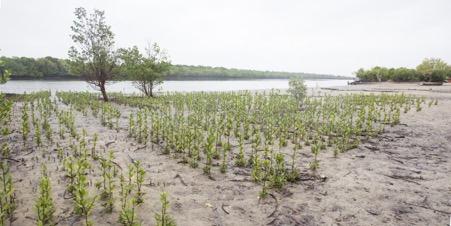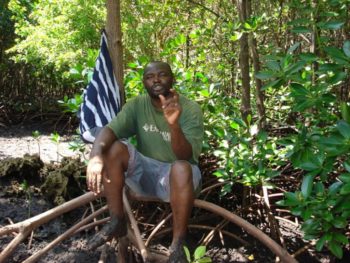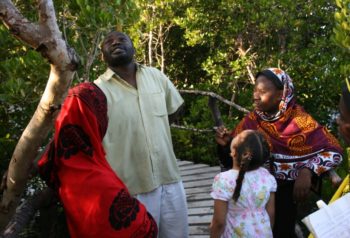Overview
Our study serves as an experimental test of intercropping in mangroves, and is examining the effects of species mixing on the soil and the fauna, including crabs and fish, present in the stands. The degraded mangrove areas of Gazi will be rehabilitated using a participatory approach, thus enhancing mangrove goods and services for the local community. Our work will enhance national and regional capacity and skills relevant to future mangrove restoration efforts.
Quick Facts
Project Location:
-4.4280127, 39.5143064
Geographic Region:
Africa
Country or Territory:
Kenya
Biome:
Coastal/Marine
Ecosystem:
Estuaries, Marshes & Mangroves
Organization Type:
Other
Location
Project Stage:
Implementation
Start Date:
2004-06-01
End Date:
2009-06-01
Primary Causes of Degradation
Deforestation, Fisheries & AquacultureDegradation Description
The mangrove forests of Gazi Bay are heavily used by local people as a fishing ground and a source of wood for building and fuel. Therefore, mangrove deforestation is widespread, with much of the forests cut down or otherwise degraded. This has left the shores of the bay muddy and vulnerable to erosion.
Project Goals
– To replant the mangroves and test how the diversity of mangrove species in replanted stands affects a range of ecosystem functions.
– To use controlled experiments to test the effects of replanted mangroves on
sediment dynamics (in both low and high energy areas), and to measure how
these effects change as the trees mature.
– To assess the effectiveness of mangroves in mitigating coastal erosion
– To collect data of direct relevance to practical restoration projects (such as the role of intercropping in enhancing productivity, and reducing disease), thus helping to inform future restoration efforts.
– To measure the capacity of planted mangrove woods to sequester carbon dioxide, and thus help to mitigate climate change, and to explore whether this
ecosystem function varies depending on the mix of species present.
– To work with local people in establishing replanted mangrove plots, which will form part of a sustainably managed local resource.
Monitoring
The project does not have a monitoring plan.
Stakeholders
On a local level, villagers rely heavily on mangroves for a range of goods and services. Thus, the outcome of this project is of critical importance to their livelihood and economic vitality.
On a national level, Kenya is a country suffering from a severe shortage of woodlands, and mangroves are often the major woodland resource along the coast. As a result, there is an urgent need to develop better mangrove management plans, and this project will provide insight into effective planning.
The conservation and rehabilitation of mangroves are global priorities and therefore, the international community should also be considered a stakeholder. Not only will this project contribute important information on how mangroves can be restored, it will also shed light on the role of mangroves in stabilizing coastlines and absorbing carbon dioxide. Both of these functions are highly significant in the face of global climate change.
Description of Project Activities:
During their first field season, Huxham and his team planted 6,077 mangrove trees in 46 experimental plots. Four different species of trees were planted: Sonneratia alba, Ceriops tagal, Avicennia marina, and Bruguiera gymnorrhiza. Planted in two separate areas where mangroves once grew, Area 1 will be used to test the different ecosystems that are created within the different mix of tree species, while Area 2 will be used to test the effects of mangroves on sedimentation and erosion.
Within area 1, the trees were planted in groups of varying combinations of one to four of the different species. This method of varying the species planted near each other will test the success of intercropping in mangroves, and will determine whether or not the mixing of two or more species of trees can make the forest more productive.
Over the next five years, both replanted areas of mangroves will be closely monitored and tested. In Area 1, scientists will focus on what is in the sediment to see how tree species diversity affects sediment quality. Area 1 will also be tested for crab diversity and abundance using binocular and burrow counting methods at ten randomly chosen points.
Area 2 will be monitored for tree survival and recruitment, or the presence and density of trees that have grown up naturally within the area.
To monitor erosion in both areas, six erosion stations have been established at random locations in each experimental plot. These consist of two 2 meters long, 5 centimeter diameter stakes, buried to 1 meter depth 1.5 meter apart. Sediment height at the midpoint between these stakes will be recorded by measuring down from a horizontal cross bar. During each field season, researchers will measure the height of the sediment to see how much erosion has taken place.
Ecological Outcomes Achieved
Eliminate existing threats to the ecosystem:
Many of the trees survived the critical first two months of establishing themselves. With an overall mortality rate of 5.2 percent, Bruguiera gymnorrhiza has shown the greatest mortality so far, while Sonneratia alba has shown the least. The success of the latter species may be due to the different site we used for planting.
Our crab measurements have shown increased biomass in planted areas, with a trend in the data towards increased biomass in plots with more species of trees.
Only one species of fish, the mangrove goby, was found in our new plantations during the initial assessment.
Factors limiting recovery of the ecosystem:
Our main beach site plots suffered grazing from goats.
Socio-Economic & Community Outcomes Achieved
Economic vitality and local livelihoods:
Already, the women of Gazi, with support from the Kenya Marine and Fisheries Research Institute, have established an ecotourism venture that profits from the value of the mangrove's scenic beauty and biodiversity.
On a broader level, though, the local people at Gazi are heavily dependent on the mangroves for direct economic uses, such as firewood and building poles (Kairo 2001), as well as for ecological services, such as nursery provision for offshore fish. The extractive uses of the mangroves present a threat to their survival (Abuodha and Kairo 2001), but also an opportunity for community involvement in their conservation. Previous community reforesting schemes at Gazi have proven successful, and the current project will attempt to build on that success by helping to sustain the supply of mangrove goods and services by involving the local community in the replanting campaign.
Long-Term Management
The people of Gazi will learn first-hand how to maintain, use, and rebuild mangrove forests so that their resource of wood and a productive fishing environment will always exist. Furthermore, over the next four years, five people will be employed to work on mangrove management, with additional occasional work for other villagers in preparing nurseries for future plantings. For this project to be successful at restoring the coastal mangroves, the community needs to be committed and involved in restoring them.
Other Resources
Kenya Marine and Fisheries Research Institute
URL: http://www.kmfri.co.ke/
Dr. James G. Cairo
Email: [email protected]




